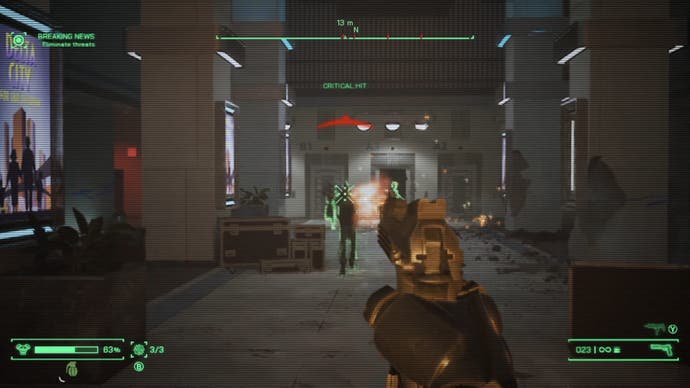Is Unreal Engine 5 'too big' for Steam Deck?
First-gen UE5 titles tested on the Valve handheld - with surprisingly positive results.
Epic's Unreal Engine 5 is swiftly becoming the engine of choice for current generation gaming. It's not hard to see why: it combines ease of use and flexibility with some of the most advanced rendering tech in the industry, especially with its Lumen and Nanite systems. At the same time, that sophistication poses a challenge for lower-power platforms, which often aren't the target for Unreal Engine 5 projects - and that extends to Valve's Steam Deck.
The Linux-powered portable powerhouse is capable of some impressive feats, but more advanced titles often don't scale well to the system. So is Unreal Engine 5 a bridge too far for the diminutive handheld or does Epic's boundary-pushing tech scale down better than you might expect?
As of early 2024, we have a nice variety of early UE5 software to take a look at - mostly lower-budget efforts, but with some very attractive entries as well. Some of these games were even included in our best graphics of the year discussion back a few weeks ago, with some seriously impressive visuals on display. But are they 'too big' for Steam Deck? In our tests, we wanted to keep the games' visual character intact, while still aiming for 30fps or better performance levels.
RoboCop: Rogue City is probably the flag-bearer of the current UE5 third party titles, with outstanding lighting and a keen use of key UE5 features. Settings-wise, I settled on the medium preset, with TSR at 50 percent resolution scale with a 720p output resolution. TSR - or temporal super resolution - actually does a pretty decent job here at cleaning up the image and keeping it presentable, especially on the internal display. We've compared TSR vs FSR 2 in this game in the past, but suffice to say that Epic's homegrown upscaling technology turns in much better results here.
The medium settings mostly deliver a good experience, but just like on Series S, they lack Lumen reflections. Turning the reflection method from SSR to Lumen costs us about 7fps our favoured 'ally with a large puddle' test scene, which is going to hurt in larger-scale shoot-outs, so I opted to stick with SSR. Overall, the visual results here look fine, but some scenes display very distracting Lumen GI noise patterns. There's just not enough resolution here to get reasonably clean real-time global illumination in a lot of circumstances, and the result is glitchy-looking image instability. Some indirectly lit areas look decent, but many do not.
Fortunately, these visual concessions do allow us to hit pretty decent performance figures. Gameplay is typically north of 30fps with these settings, with solid frame-rates in area traversal and combat alike. During more intense combat moments, we hover somewhere just above 30fps, with more sedate moments bringing a considerable frame-rate uplift to the 40s and 50s. There are still issues with higher-latency frames, as 50ms frames are sprinkled into the mix every so often, and there are still the same traversal stutter problems in the same areas as the console code. Overall though, I'm quite pleased with the performance level - just keep in mind that the performance figures for a Steam Deck OLED running at 90Hz on the internal display with a 30fps cap will present differently to 30fps on the LCD Deck, with higher latency on the older model.

Overall, I think RoboCop presents a mixed, but somewhat positive impression of Unreal Engine 5 on Valve's Linux-based handheld. If you ignore some of the Lumen artifacts, this title offers a similar-to-console visual experience, and the performance, while well short of 60fps, is still good enough to give a decent enough 30fps ride.
Immortals of Aveum follows the same template as RoboCop. The settings menu is a bit unconventional here, so settled on low settings as there is no medium or equivalent preset. I dialled up texture resolution to high, because it doesn't seem to carry a performance penalty, and global illumination to high, to give us a console-like Lumen GI presentation. I've pegged the resolution to 720p, with FSR 2 in performance mode to hopefully give us a manageable performance level. There's no option for TSR unfortunately in the options menu, so we're left with a somewhat artifact-ridden FSR resolve. PC UE5 developers: if you're supporting FSR 2, please include TSR too!
Comparisons against the Series S console code are fascinating. The Steam Deck isn't delivering stunning visuals, but it looks better a lot of the time than Microsoft's junior ninth-gen console. The Series S looks soft and low-detail in comparison, with muddy texture-work, restricted LODs, and missing ground clutter. The Lumen GI is noticeably pared-back though vs Series S, though this applies to both Deck and the junior Xbox. Immortals' use of Lumen is perhaps not up to the same standard as RoboCop - but the Steam Deck has a much fainter impression of that lighting detail. On the plus side though, I didn't usually notice much boiling or flickering in the Deck's Lumen presentation.

We're looking at a familiar just-north-of-30fps experience here, with frame-rates generally in the 30fps to 40fps region during typical play. There are more frequent 50ms frames here though, which can breach a 30fps frame-rate cap. I noticed some traversal stutters from time to time, like many UE5 titles, which again are more frequent here than in RoboCop. For a portable experience with arguably superior-to-console visuals, the performance readout here is decent enough, if slightly unsteady at the margins.
Let's take a bit of a left turn and look at Jusant, Don't Nod's rock climbing adventure. I've dialled in high settings across the board to give us a generally console-level visual experience. Looking at the Series S code, the fine lighting detail of that version is lacking, but the game looks quite similar on the whole. Lumen GI is comparable enough, and virtual shadow maps make an appearance here, just at a noticeably lower resolution. Image quality is pretty good, though a step down from consoles.
There's a choice of FSR 2 and TSR in this game, but something's up with the TSR, as at the minimum point on the slider at 720p output we're getting just above half the frame-rate of FSR 2 in its performance mode. Perhaps that minimum resolution is pegged a bit too high to be useful for us here. In any case, the lower-detail artwork is a good match for FSR 2's typical image quality characteristics, so the game looks stable and smooth enough in typical play.

Frame-rates are typically quite solid, often in the 40s and 50s, with a very good performance level. There are some 50ms frames sprinkled in sometimes, and those classic traversal stutters do make a return appearance, but it's usually a good deal above 30fps. There are some occasional moments where there is an extended run of mid-to-high 20s performance though, which sometimes occur with larger views of the environment. Jusant is very slow-paced, and I think the performance level is good considering the beautiful visuals on display, but it's not perfect.
The Talos Principle 2 is perhaps the most interesting game I tested on the Steam Deck. The Series S version of this title actually lacks Lumen GI, opting instead for a hand-placed array of fill lights throughout the world. But on Steam Deck, we can get the full Lumen GI experience, as long as we opt for high settings or above. That gives us an almost generational improvement in lighting fidelity, which means the Deck actually looks a bit better than Series S in my opinion. Image quality is solid too, with TSR in its performance mode doing a great job of presenting a coherent and detailed image at all times.
The performance level here is the best of all the games I've looked at so far, usually hovering in the 40s or even 50s, with a stable frame-rate readout mostly free of high-latency frames. Overall this performance level offers a very satisfying puzzle experience, with plenty of headroom to deliver a good 30fps cap - or even experiment with 40fps. I'm not going to say Talos Principle is the best-looking game in my choice of UE5 titles, but it's still an attractive effort and runs great on the Steam Deck OLED. That it's arguably visually superior to the Series S version is just icing on the cake.

Unfortunately, Fort Solis doesn't fare quite as well. Settings-wise, I settled on the medium preset, with ultra performance FSR 2 at 720p. I didn't want to dip all the way down to ultra performance as core resolution is so vanishingly small, but the frame-rate gain is needed, with only the lowest-res preset capable of 30fps and above performance on a consistent basis. There's no built-in TSR unfortunately, so we have to stick with FSR 2, leaving us with poor image quality and lots of flickering and artifacting everywhere. Lumen GI isn't doing us any favours, though with that said, there are also substantial Lumen artifacts in the PS5 code. It just doesn't hold together technically, even if we are getting a healthy chunk of Unreal Engine 5 features.
Frame-rates are mostly pegged above 30fps, which is useful for our purposes, but the game does suffer from occasional stuttering issues that are highly distracting and there are some bouts of sub-30fps performance as well. It's just a step too far for the Steam Deck hardware to manage, a situation perhaps exacerbated by the lack of a Series S version to force further optimisation.
I'd recommend a 30fps cap for most of these games (even 40fps is a little too optimistic) and you'll need to bear in mind that I was testing on Steam Deck OLED, which has a small performance advantage over the older LCD model - usually in the order of an extra two or three frames per second or so. In matching footage, the OLED model tends to have a consistent performance edge and some of the stutters and little frame-time hitches I observed on the LCD Deck are cleaned up on the newer unit too. Most of what I've said so far applies similarly to both units, but you will definitely feel the performance delta between the two units in some of these titles, even with a 30fps cap in place.
So is Unreal Engine 5 "too big for Steam Deck"? I don't think so - but you need to accept some brutal compromises in resolution. Even so, they work and these early titles are a good indication that UE5 titles can scale well to the Steam Deck. Granted, these are somewhat less complex games than we're likely to see in the coming years, but they manage to run decently well on Steam Deck hardware, with the exception of Fort Solis. Key parts of the UE5 feature set, like Lumen, can function on the Deck and even excel, depending on the game. And performance is firmly in playable territory, with broadly 30fps and above frame-rates.
We aren't getting the full high-end PC or console experience here, but considering the hardware, the results are quite good. Given the way other high-end titles can run on the Deck, I really wasn't expecting these UE5 titles to run as well as they do. And the Steam Deck OLED's display is a great way to show off the kind of dynamic lighting detail UE5 is capable of.
Unreal Engine 5, despite all my expectations, proves a decent match for the Steam Deck. Titles like Hellblade 2 or STALKER 2 may prove a challenging fit, but for now the Deck is well-suited to typical UE5 workloads.









